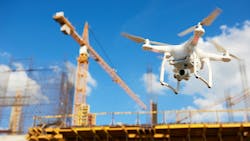Is the Deadliest Job in America Ready for an AI Safety Net?
For three years running, construction has held the grim distinction of being one of the deadliest jobs in America. According to the Occupational Safety and Health Administration (OSHA), American construction sites witness nearly 15 worker fatalities every single day.
These are statistics that we can’t afford to accept. Nearly every other industry leverages technology to improve the safety and security of its workforce, but despite its critical role in society, construction is one of the last to embrace its transformative capabilities. The very tools that many fear will displace construction workers are actually the keys to protecting them.
The conversation around automation in construction needs a fundamental reset. This is not about replacing human ingenuity but augmenting it. It's about building a safety net woven from data, algorithms, and intelligent automation, ensuring that the people who build the world around us are kept out of harm's way. We need to build a safer, more human-centric industry from the ground up.
The Hidden Cost of "Fixing It Later": How Rework Endangers Lives
On any given project, one of the most significant, yet underestimated, threats to worker safety is rework. Rework is any work within a construction project which has to be done again due to a mistake or a compliance issue. A study published by the Journal of Construction Engineering and Management found that the OSHA recordable injury rate is impacted directly by the rates of rework.
When a design flaw or process-related error is discovered mid-construction, it often triggers a domino effect of hazardous events. Schedules are compressed, creating pressure to rush. Teams from different trades, who were supposed to work in a coordinated sequence, are now forced to operate at the same time in spaces not designed for simultaneous activity.
Unplanned material deliveries clutter the site, creating trip-and-fall hazards. Teams may lose motivation and attention to detail when tearing down their initial work just to redo it. These scenarios would have been anticipated and avoided in the original safety plan, but overlooked in a rushed, rework situation.
Rework invalidates the best-laid safety plans and forces workers into high-risk, improvisational problem-solving. The root cause, however, isn't a lack of skill or organization on the site; it's a lack of precision in the design. We’ve been operating under a paradigm where the design is merely a suggestion, an initial sketch to be figured out on-site. To truly tackle safety, we must start the conversations earlier with pre-construction prevention.
The First Level of PPE: AI-Powered Design
The solution lies in transforming how we think about construction design. For decades, computer-aided design (CAD) tools have been essentially sophisticated drafting boards. They documented a designer's ideas, but lacked any intelligence about the actual construction. The real revolution comes when we shift from merely documenting decisions to actively involving computation in making them. AI can bring a wealth of construction knowledge to the design phase, providing insight into what’s truly constructible.
This evolution is most evident in the application of Building Information Modeling (BIM) and generative AI. While BIM creates a detailed digital representation of a building's physical and functional characteristics, generative AI takes it a step further. By inputting the core parameters of a project - site data, architectural intent, engineering requirements, and local building codes - AI can explore a vast landscape of design possibilities. It generates detailed, constructible, and code-compliant models that consider not just the final form, but the entire assembly process. This level of design precision is rarely achieved today, as by using conventional means it requires a very substantial investment of time and skilled personnel, and most projects face significant time and cost restraints.
This digital-first approach allows for a proactive safety strategy. AI-driven designs produce precise, unambiguous instructions that reduce the dangerous guesswork and rework that often leads to on-site accidents.
Automating the Danger: Robotics in the Background and on the Front Line
Robotics can also contribute to a safer job site by performing prefabrication tasks off-site and keeping humans out of harm’s way on the site. Robots can review and execute prefabrication plans, drones can be used to inspect the tallest scaffolding, robotic arms can take the brunt of repetitive, heavy lifting, and automated systems can manage welding and painting in hazardous environments.
We’re not advocating for removing humans from the construction process or the job site. In fact, the industry is already facing a labor shortage of over 382,00 unfilled construction jobs and an aging workforce. Instead, robotics can be used to strategically remove workers from the tasks where they are underutilized or vulnerable. While a robot handles the strain of laying concrete blocks, a human can focus on quality control and the intricate details of their chosen trade.
The Digital Watchtower: Real-Time Monitoring
Beyond automating physical tasks, AI can also serve as an intelligent, ever-present monitoring system for the entire job site. AI-enabled cameras and sensors can aid the safety supervisor in real-time. This creates a powerful layer of proactive oversight that can prevent accidents before they happen.
Computer vision systems can verify that workers are wearing the correct PPE, detect when a worker enters a restricted or hazardous zone, and alert supervisors to potential dangers like an unsecured ladder or a nearby vehicle moving in an unsafe manner. In the future, AI can also provide wearable sensors, embedded in hard hats or vests, which can monitor a worker's vital signs for heat exhaustion or overexertion. This constant stream of data creates a feedback loop, allowing for immediate intervention and continuously improving safety protocols for future projects.
Building a Future Where Everyone Goes Home Safe
The path to a safer construction industry is paved with data and powered by intelligence. By embedding AI into the design process, we can address the root cause of countless accidents before they occur. Once on-site, we can automate the most dangerous tasks and monitor job sites with a vigilance that understaffed teams cannot achieve today.
This technological evolution will elevate the role of the construction worker. It will free humans from the most dangerous, dull, and physically taxing aspects of the job, empowering them to focus on what they do best: problem-solving, critical thinking, and skilled craftsmanship.
The future of construction is one where technology augments human skill and creates an environment where safety is not a matter of compliance, but a fundamental characteristic of the design itself. We have the tools and the moral responsibility to build this future now to ensure every construction worker returns home safely at the end of every day.
About the Author

Francesco Iorio
Francesco Iorio is a co-founder and CEO of Augmenta, where he assembles experts from artificial intelligence, advanced computational science and user-centered design to transform the way buildings are designed and built.
Before Augmenta, Iorio served as Director of Computational Science Research at Autodesk Research where he led a group of researchers and engineers in exploring state-of-the-art computational science projects that pioneered modern generative design.
Previously, Iorio was a solution architect for next generation computing systems at the IBM High Performance Computing Group in Dublin, Ireland, specifically focusing on accelerating financial, engineering and digital media workloads using hybrid high-performance computing platforms.
He holds a MSc in information technology from the University of Liverpool and a PhD in computer science from the University of Toronto.
